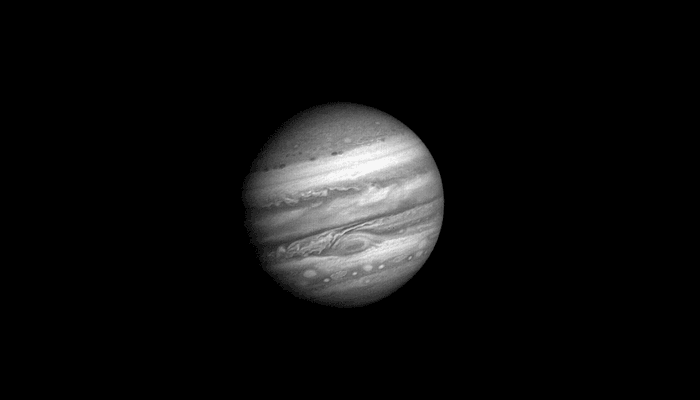Posts tagged 'Voyager'
Bells
“The majority of the 3D models used in the video are based on real objects from Space; the Hubble Space Telescope, Progress and Voyager 1. The planets and moons in the video are generated using NASA imagery, and helped to create a formal aspect to an otherwise abstract piece.”
As anyone who frequents this site knows, I’m a big fan of ‘wormhole’ videos. That’s not a formal, industry term or whatever just a little tag I started attaching to any video with a significant portion dedicated to taking bringing the viewer on a journey directly towards (or away from) the center of the frame. The first one I can remember seeing is 2001’s infamous ‘Star Gate’ slitscan sequence and I disctinctly remember wishing it had been twice (or three times) as long.
Ever since the inception of this site over three years ago I’ve tried to collect the best examples of the form and my current favorites are Max Hattler’s Sync, the bizarre and whimsical Pelican by David Wilson Creative (for The Maccabees), Jesse Kanda’s psychedelic sea-punk music video for Arca’s Manners, Quantum Leap by Thomas de Rijk (for Slugabed), and Carl Burton’s supremely strange and intriguing short film, Shelter.
Attached above is a video – by Stuart Sinclair – that fits in nicely with the aforementioned watchables. The glitchy, looped-and-syncopated music by Suns is just-right for a dive through space and the wire-frame visuals heighten the futuristic, tech-drenched vibe.
Top-marks all the way ‘round. ENJOY!
Oh and be sure to check out our wormhole feed, it’s not-to-be missed.
posted by respondcreate on Nov. 10, 2013 in Videos | tags: abstract, animation, hd, music video, space, stuart sinclair, suns, technology, vector, voyager, wormhole
Stardust
”Voyager 1 and Voyager 2 are the ships that opened the Solar System for the human species, trailblazing a path for future generations. Before their launch, in August and September 1977, we were almost wholly ignorant about most of the planetary part of the Solar System. In the next dozen years, they provided our first detailed, close-up information on many new worlds–some of them previously known only as fuzzy disks in the eyepieces of ground-based telescopes, some merely as points of light, and some whose very existence was unsuspected. They are still returning reams of data.
These spacecraft have taught us about the wonders of other worlds, about the uniqueness and fragility of our own, about beginnings and ends. They have given us access to most of the Solar System–both in extent and in mass. They are the ships that first explored what may be homelands of our remote descendants.” – from Pale Blue Dot by Carl Sagan
I’ve always been rathered enamoured with the Voyager program – especially the Golden Record, which you’ll get a close-up of at 2:35 – and the fantastic visuals in the attached short by PostPanic do a great job of embroidering JPL‘s masterwork with an appropriate sense of reverence and wonder.
Stardust‘s director, Mischa Rozema, wanted to (among other things) create a film that showed what the universe looked like, “from a different point of view. For example, standing on the surface of the sun looking upwards or witnessing the death and birth of a star - not at all scientifically correct but instead a purely artistic interpretation of such events.”
As you’ll see, he succeeded and the end result (for me, at least) provided a much needed shift in perspective. It’s gorgeous; the perfect companion for a late-night, contemplative, solitary sesh. Enjoy!
[ Stardust ]
posted by respondcreate on Feb. 20, 2013 in Videos | tags: animation, astronomy, hd, mischa rozema, nasa, perspective, postpanic, space, spiritual, voyager
Voyager 1 Approaches Jupiter

“One frame of this image was taken each Jupiter day (approximately 10 hours) between January 6 and February 9, 1979, as the space probe [Voyager I] flew from 58 million to 31 million kilometers from Jupiter during that time. The small, round, dark spots appearing in some frames are the shadows cast by the moons passing between Jupiter and the Sun, while the small, white flashes around the planet, are the moons themselves.”
Inspired by the gorgeous shot of Jupiter’s ‘Great Red Spot’ tizmatti posted a couple of weeks back, I decided to read up on Jupiter’s unique atmosphere. Turns out it’s a pretty tumultuous place comprised of constantly shifting cloud layers and swirling, violent vortices (of which the ‘Great Red Spot’ is the largest). It’s truly fascinating stuff.
[ NASA: Jupiter via Wikipedia ]
posted by respondcreate on Apr. 08, 2011 in Pictures | tags: animated gif, astronomy, jupiter, nasa, science, space, time lapse, voyager